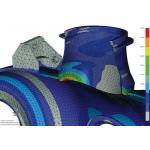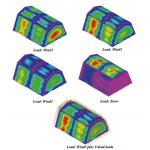Safer Living Through FEA
From powered parachutes to valve-seals for nuclear plants, moreproducts than ever rely on finite element analysis to perform safely.
Latest News
September 1, 2006
By Pamela J. Waterman
What do a chemical fire extinguisher, a vehicle maintenance shelter, and a private submarine have in common? They’re all designed to operate safely in the face of extremely demanding conditions, and finite element analysis (FEA) software is the tool that makes them reliable.
As consumers, we take for granted that mechanical systems will operate safely, whether those systems are used daily or represent unique structures. Here, we’ll look at a number of cases where FEA simulations, applied with skill and experience, ensure such functionality.
Grace Under Pressure
Not many people get to design a submarine; fewer still are called upon to evaluate such a design for safety. George Laird, chief technologist at Predictive Engineering in Seattle, took on the task of evaluating the design of a pleasure-viewing underwater craft for a private customer. Laird received the CAD model of a 40-foot long, 10-passenger vessel designed for operation down to 1,200 feet. Its weight was constrained by the carrying capacity of an existing yacht. The unique design deviated from the standard American Bureau of Shipping (ABS) code for hull thickness, frame stiffness, and porthole and hatch design, so certifying its safety was a special challenge for Predictive Engineering, an FEA consulting service.
|
|
| Courtesy of Predictive Engineering. |
> > This analysis focuses on the forward hatch of a private submarine. The 67,000-node, 58,000-element model was run numerous times through Nastran.
The design uses traditional formula-based techniques but incorporated unusually large viewing ports and numerous holes penetrating the hull that allow various cables to pass through. Laird had to provide a virtual evaluation of the hull’s mechanical performance prior to construction and sea trials, predicting global buckling behavior and local stress concentrations based on FEA methods. This entailed investigating the effects of such factors as out-of-roundness in sections of the circular, cylindrical hull, as well as the yield strength of the various welds in A517 Grade A steel.
Using Femap from UGS to import the 3D model (combined geometry from Pro/Engineer and Autodesk Inventor), Laird set up the analysis parameters. He constructed the model as a blend of 4-node plate elements (representing the hull’s skin and outer reinforcement rings) and 8-node brick elements (representing the forged structures such as hatches and viewing ports). Applying the pressure loads was difficult because the analysis had to mimic the fact that as a sub dives, it is under hydrostatic pressure (forces balanced and summed to zero). Running the 67,000-node, 58,000-element model through Nastran numerous times with refinements, Laird predicted a 2.48 safety factor. The results coordinated so well with actual strain-gauge measurements made at the target-depth that the ABS certified the submarine based on numerical methods instead of its standard code.
|
|
| Courtesy of Predictive Engineering. |
< < Coarse FEA model of complete submarine hull for safety analysis.
In another high-pressure example, but this one looking from the inside out, engineers at the Palo Verde Nuclear Generating Station (PVNGS) near Phoenix, AZ, recently had a problem with a new valve-seal subassembly. This facility, with the largest capacity of any nuclear power plant in the United States, conducts regular maintenance and upgrades of mechanical components and assemblies. The sub-assembly issue involved tightening the bolts in a clamp-ring around the perimeter of a bonnet check valve. The seal occurs when the clamp exerts force on a retainer ring, which in turn crushes a soft graphite seal ring capped with stainless steel that pushes on the rim of the valve bonnet surface.
As the unit was brought into operation, pressure was applied in increments. This caused an asymmetric loss of preload on the bolts, and an actual tilting of the valve bonnet surface. Although sealing pressure was not compromised, some of the graphite material was squeezed out of the assembly.
PVNGS called in Sanjeev Kulkarni of KB Engineering in Tempe, AZ, to evaluate alternative design parameters and installation procedures, focusing on the initial pre-load applied to the bolts, and the design of the stainless seal cap, whose material behaves in an elastic-plastic manner as it compresses the graphite.
Kulkarni used Abaqus FEA software to analyze the nonlinear contact behavior between the surfaces, including plasticity, thermal gradients, and large structural deformation behaviors. The software also had to solve multi-step problems, and allow modifying properties as the analysis progressed—an essential requirement, as the properties of the graphite keep changing throughout the crushing process.
Based on Abaqus simulations, Kulkarni determined that modifying two parameters, seal cap thickness and initial bolt preload pressure, gave the greatest improvements. This would maintain a 20 percent higher preload during the process and cut peak stress by 40 percent, resulting in safer overall installation and operation.
Controlled Forces Do the Job
Several years ago, United Technologies Corp. began an initiative called modeling, analysis, simulation, and computation (MASC) to achieve competitive differentiation with improved products and processes. One such example addressed the multiphysics involved in a special fire-fighting system for commercial building protection.
System designers at the United Technologies Research Center (UTRC) near the company’s headquarters in Hartford, CT, point out that the only thing that makes fire worse for computers, documents, and valuable art is adding water to extinguish the flames. UTRC designs fire-suppression systems based on discharging inert gases into a room to lower the concentration of oxygen, and thus snuff out the flames. Besides being non-water-based, the system is attractive because it can fight fire in ventilation systems or behind walls.
When a sensor detects a fire, tanks release a non-combustible, non-toxic gas through a nozzle; when the gas expands, its temperature drops correspondingly to as low as —78° C, forcing the oxygen out of the room and dropping its concentration to or below 12 percent. However, releasing the gas too quickly pressurizes the room, risking window blowout.
To determine gas-control system parameters that avoided installing large, unattractive relief vents in each room, UTRC’s Mike Dorobantu teamed up with Jesper Oppelstrup of the Royal Institute of Technology in Stockholm, Sweden. Both analysts worked with COMSOL Multiphysics to create files combining different models accounting for incompressible gas discharge, room pressures, boundaries, chemical mixing reactions, and heat transfers.
COMSOL Multiphysics’ capabilities allowed Dorobantu and Oppelstrup, each working remotely on the same models, to jointly analyze jet-expansion performance while optimizing the positions of the sensors, vents, and gas-release nozzles in differently sized and shaped rooms. The results guided the system design to allow efficiently suppressing a fire without creating overpressure conditions.
Handling Stress and Shock
Powered parachutes are recreational crafts operated by daredevils who, until recently, flew the machines from cockpits that resembled repackaged go-carts or recumbent bicycles. To break away from this styling rut, Alliant Engineering applied its product-design skills based on 10 years of experience using COSMOS FEA software to develop the first load-bearing composite fuselage in the powered parachute market. Their goal for client Fantom Aerosports was to create a sleeker, updated design that maintained the strength, and therefore safe operation, of the traditional aluminum-frame design.
|
|
| Courtesy of Alliant Engineering. |
> > Alliant Engineering used COSMOS FEA to design the first load-bearing composite fuselage for its Paracraft powered parachute.
Since weight is a critical factor in designing any flying craft, Alliant knew it wanted to take the approach of a tubeless body made from a stress-skin composite. According to Alliant Co-owner and President Jim Medsker, when dealing with such a load-bearing, complex structure, you need a powerful FEA tool.
Using the combination of SolidWorks and COSMOSWorks design and analysis software, Alliant engineers were able to optimize the design for weight and strength under continuous loads of 10G. They validated all components including the body, crumple zones, chute arms, safety cable areas, and loading struts with minimal physical testing. The result, in just six months, was a sleek, strong body with undeniably cool lines.
Perhaps less glamorous but equally challenging in the weight-reduction category is the redesign of tent structures known in military lingo as vehicle maintenance shelters (VMS).
Used primarily to house and service vehicles, the structures must withstand wind, snow, and the weight of suspended accessories. Design constraints include an 8-foot maximum length on all parts for packing purposes.
Anchor Industries recently entered this market, having supplied tents and lightweight portable buildings and structures to the outdoor amusement and entertainment industries for more than a century. Anchor took aim at a competitor’s unit that weighs over 1,600 pounds, requires 16 people to carry and assemble, and comes with a 276-page instruction manual. However, Anchor’s first results were overpriced.
The company’s senior structural engineer, Richard Cook, then turned to Algor FEA to create a more competitive and efficient design. To save costs and weight, Cook created an FEA model based on existing extrusions, with the frame composed of arches, tension cables, and purlins (horizontal beams made of proprietary square aluminum tubes). Vertical beams incorporated channels into which fabric panels could slide, eliminating tie-downs. Beams and purlins had to be spliced for disassembly.
|
|
| Courtesy of ALGOR, Inc. |
|
|
| Anchor Industries |
Anchor Industries used ALGOR FEA to simulate various wind, snow, and dead weight loads on a new design for a military vehicle maintenance shelter. The fabric was modeled with 1,200 elements, the frame with 600 beam elements. The analysis resulted in a 40 percent weight reduction in the design. Click images to enlarge.
Representing the fabric covering with 1,200 membrane elements, and the frame with 600 beam elements, Cook meshed the structural components and defined various combinations of loads due to wind, snow, and dead weight. Using Algor’s mechanical event simulation program to consider nonlinear effects in the cabling over 20-second periods, Cook optimized the design and then verified it against field tests. The analysis permitted building a VMS with a 40 percent weight reduction and consequent manpower and cost savings.
Safety Simulation Successes Everywhere
FEA-based simulations are helping speed up design, reduce material costs, and maintain safety in an ever-growing list of applications. Even TV shows are using FEA. MythBusters, a PBS program that examines urban legends large and small, turned to COSMOS software when a question of insurance came up. By analyzing trends in how safely some modified mechanisms would behave, the Myth Busters team was able to talk down its own insurance rates!
More examples of engineering simulations are proving so accurate that even the U.S. Food and Drug Administration is starting to accept them to minimize animal testing. Stay tuned to DE for more articles on this topic.
Contributing Editor Pamela J. Waterman is an electrical engineer and freelance technical writer based in Arizona. You can contact her about this article via e-mail by clicking here. Please reference “Safer FEA, October 2006” in your message.
Company Information
Abaqus, Inc.
Providence, RI
ALGOR, Inc.
Pittsburgh, PA
Alliant Engineering LLC
Kalamazoo, MI
ANSYS, Inc.
Canonsburg, PA
ARA Engineering, Inc.
Mesa, AZ
Autodesk, Inc.
San Raphael, CA
COMSOL, Inc.
Burlington, MA
COSMOS
A Division of SolidWorks Corp.
Santa Monica, CA
Fantom Aerosports
White Pigeon, MI
KB Engineering, Inc.
Tempe, AZ
MSC.Software Corp.
Santa Ana, CA
Noran Engineering, Inc.
Westminster, CA
Palo Verde Nuclear Generating Station
Wintersberg, AZ
Predictive Engineering, Inc.
Seattle, WA
PTC
Needham, MA
SolidWorks Corp.
Concord, MA
Takata Corp.
Auburn Hills, MI
UGS Corp.
Plano, TX
United Technologies Corp.
Hartford, CT
Subscribe to our FREE magazine, FREE email newsletters or both!
Latest News
About the Author
Pamela Waterman worked as Digital Engineering’s contributing editor for two decades. Contact her via .(JavaScript must be enabled to view this email address).
Follow DE










